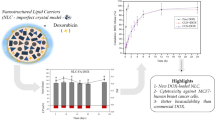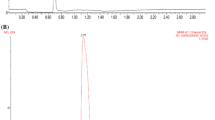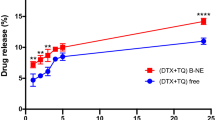Abstract
Breast cancer is the most common cancer of occurrence in women and has the highest mortality incidence rate therein. The present study envisaged to develop doxorubicin (Dox) loaded folate functionalized nanoemulsion (NE) for profound therapeutic activity against mammary gland cancer. NE was prepared using pseudo-ternary phase diagrams utilizing α-linolenic acid (ALA) as lipid phase, to further enhance the anticancer potential of Dox. Box-Behnken design was employed to systematically develop the NE. Optimized NE (f-Dox-NE) was evaluated for in vitro and in vivo performance. f-Dox-NE, with globule size 55.2 ± 3.3 nm, zeta potential − 31 ± 2 mV, entrapment 92.51 ± 3.62%, drug loading 0.42 ± 0.08% and percent drug release 94.86 ± 1.87% in 72 h, was capable of reducing cell viability in MCF-7 cell lines vis-à-vis pure and marketed drug. Further, mechanistic studies in MCF-7 cell lines demonstrated that f-Dox-NE induces cellular apoptosis by reactive oxygen species generated and mitochondrial membrane mediated apoptosis. The antitumor effect was evaluated in 7,12-dimethylbenz[a]anthracene (DMBA) induced mammary gland tumor in female Albino Wistar rats. f-Dox-NE exhibited enhanced antitumor targeting potential, therapeutic safety and efficacy vis-à-vis pure and marketed drug, as revealed by tumor volume, animal survival, weight variation, cardiotoxicity and biodistribution studies. f-Dox-NE restored the biochemical parameters viz., SOD, catalase, TBARS and protein carbonyl, towards normal levels in comparison to DMBA induced animal group. f-Dox-NE displayed downregulation of anti-apoptotic (Bcl-2 and MMP-9) proteins and upregulation of pro-apoptotic proteins (caspase-9 and BAX). The experimental results suggest that ALA augmented folate functionalized NE are able to overcome the challenges of develo** safe and effective delivery system with enhanced potential for mammary gland carcinoma therapy.
















Similar content being viewed by others
References
Siegel RL, Miller KD, Jemal A. Cancer statistics, 2017. CA Cancer J Clin. 2017;67(1):7–30.
Wang X, Teng Z, Wang H, Wang C, Liu Y, Tang Y, et al. Increasing the cytotoxicity of doxorubicin in breast cancer MCF-7 cells with multidrug resistance using a Mesoporous silica nanoparticle drug delivery system. Int J Clin Exp Pathol. 2014;7(4):1337–47.
Ma J, Jemal A. Breast cancer statistics. In: Ahmad A, editor. Breast cancer metastasis and drug resistance. New York: Springer; 2013.
Ferlay J, Héry C, Autier P, Sankaranarayanan R. Global burden of breast Cancer. In: Li C, editor. Breast cancer epidemiology. New York: Springer; 2010.
Trivedi PP, Kushwaha S, Tripathi DN, Jena GB. Cardioprotective effects of hesperetin against doxorubicin-induced oxidative stress and DNA damage in rat. Cardiovasc Toxicol. 2011;11(3):215–25.
Ogretmen B, Safa AR. Down-regulation of apoptosis-related Bcl-2 but not bcl-xL or BAX proteins in multidrug-resistant MCF-7/Adr human breast cancer cells. Int J Cancer. 1996;67(5):608–14.
Vimala K, Sundarraj S, Paulpandi M, Vengatesan S, Kannan S. Green synthesized doxorubicin loaded zinc oxide nanoparticles regulates the Bax and Bcl-2 expression in breast and colon carcinoma. Process Biochem. 2014;49(1):160–72.
Karroum A, Mirshahi P, Faussat AM, Therwath A, Mirshahi M, Hatmi M. Tubular network formation by adriamycin-resistant MCF-7 breast cancer cells is closely linked to MMP-9 and VEGFR-2/VEGFR-3 over-expressions. Eur J Pharmacol. 2012;685(1–3):1–7.
Park SJ, Wu CH, Safa AR. A P-glycoprotein- and MRP1-independent doxorubicin-resistant variant of the MCF-7 breast cancer cell line with defects in caspase-6, -7, -8, -9 and -10 activation pathways. Anticancer Res. 2004;24(1):123–31.
Roy S, Rawat AK, Sammi SR, Devi U, Singh M, Gautam S, et al. Alpha-linolenic acid stabilizes HIF-1 α and downregulates FASN to promote mitochondrial apoptosis for mammary gland chemoprevention. Oncotarget. 2017;8(41):70049–71.
Calder PC. The role of marine omega-3 (n-3) fatty acids in inflammatory processes, atherosclerosis and plaque stability. Mol Nutr Food Res. 2012;56(7):1073–80.
Singh M, Kanoujia J, Singh P, Tripathi CB, Arya M, Parashar P, et al. Development of an α-linolenic acid containing soft nanocarrier for oral delivery: in vitro and in vivo evaluation. RSC Adv. 2016;6(81):77590–602.
Tripathi CB, Beg S, Kaur R, Shukla G, Bandopadhyay S, Singh B. Systematic development of optimized SNEDDS of artemether with improved biopharmaceutical and antimalarial potential. Drug Deliv. 2016;23(9):3209–23.
Jiang SP, He SN, Li YL, Feng DL, Lu XY, Du YZ, et al. Preparation and characteristics of lipid nanoemulsion formulations loaded with doxorubicin. Int J Nanomedicine. 2013;8:3141–50.
Mizushima Y. Lipid microspheres (lipid emulsions) as a drug carrier—an overview. Adv Drug Del Rev. 1996;20(2–3):113–5.
Kouchakzadeh H, Soudi T, Heshmati Aghda N, Shojaosadati SA. Ligand-modified biopolymeric nanoparticles as efficient tools for targeted cancer therapy. Curr Pharm Des. 2017; https://doi.org/10.2174/1381612823666170526101408.
Kandadi P, Syed MA, Goparaboina S, Veerabrahma K. Albumin coupled lipid nanoemulsions of diclofenac for targeted delivery to inflammation. Nanomed Nanotech Biol Med. 2012;8(7):1162–71.
Liu Y, Yu XM, Sun RJ, Pan XL. Folate-functionalized lipid nanoemulsion to deliver chemo-radiotherapeutics together for the effective treatment of nasopharyngeal carcinoma. AAPS Pharm Sci Technol. 2017;18(4):1374–81.
Weitman SD, Lark RH, Coney LR, Fort DW, Frasca V, Zurawski VR Jr, et al. Distribution of the folate receptor GP38 in normal and malignant cell lines and tissues. Cancer Res. 1992;52(12):3396–401.
Weitman SD, Weinberg AG, Coney LR, Zurawski VR, Jennings DS, Kamen BA. Cellular localization of the folate receptor: potential role in drug toxicity and folate homeostasis. Cancer Res. 1992;52(23):6708–11.
Salazar MD, Ratnam M. The folate receptor: what does it promise in tissue-targeted therapeutics? Cancer Metastasis Rev. 2007;26(1):141–52.
Huan ML, Zhou SY, Teng ZH, Zhang BL, Liu XY, Wang JP, et al. Conjugation with alpha-linolenic acid improves cancer cell uptake and cytotoxicity of doxorubicin. Bioorg Med Chem Lett. 2009;19(9):2579–84.
Singh B, Kapil R, Nandi M, Ahuja N. Develo** oral drug delivery systems using formulation by design: vital precepts, retrospect and prospects. Expert Opin Drug Deliv. 2011;8(10):1341–60.
Lee RJ, Low PS. Delivery of liposomes into cultured KB cells via folate receptor-mediated endocytosis. J Biol Chem. 1994;269(5):3198–204.
Bae PK, Jung J, Lim SJ, Kim D, Kim SK, Chung BH. Bimodal perfluorocarbon nanoemulsions for nasopharyngeal carcinoma targeting. Mol Imaging Biol. 2013;15(4):401–10.
Stella B, Arpicco S, Peracchia MT, Desmaële D, Hoebeke J, Renoir M, et al. Design of folic acid-conjugated nanoparticles for drug targeting. J Pharm Sci. 2000;89(11):1452–64.
Lee ES, Na K, Bae YH. Doxorubicin loaded pH-sensitive polymeric micelles for reversal of resistant MCF-7 tumor. J Control Release. 2005;103(2):405–18.
Riccardi C, Nicoletti I. Analysis of apoptosis by propidium iodide staining and flow cytometry. Nat Protoc. 2006;1(3):1458–61.
O'Brien J, Wilson I, Orton T, Pognan F. Investigation of the Alamar Blue (resazurin) fluorescent dye for the assessment of mammalian cell cytotoxicity. Eur J Biochem. 2000;267(17):5421–6.
Ottonello L, Frumento G, Arduino N, Dapino P, Tortolina G, Dallegri F. Immune complex stimulation of neutrophil apoptosis: investigating the involvement of oxidative and nonoxidative pathways. Free Radic Biol Med. 2001;30(2):161–9.
Al-Qubaisi MS, Rasedee A, Flaifel MH, Ahmad SH, Hussein-Al-Ali S, Hussein MZ, et al. Induction of apoptosis in cancer cells by NiZn ferrite nanoparticles through mitochondrial cytochrome C release. Int J Nanomedicine. 2013;8:4115–29.
Arya M, Tiwari P, Tripathi CB, Parashar P, Singh M, Sinha P, et al. Colloidal vesicular system of inositol hexaphosphate to counteract DMBA induced dysregulation of markers pertaining to cellular proliferation/differentiation and inflammation of epidermal layer in mouse model. Mol Pharm. 2017;14(3):928–39.
Dharmalingam SR, Ramamurthy S, Chidambaram K, Nadaraju S. A simple HPLC bioanalytical method for the determination of doxorubicin hydrochloride in rat plasma: application to pharmacokinetic studies. Trop J Pharm Res. 2014;13(3):409–15.
Komaiko J, Sastrosubroto A, McClements DJ. Formation of oil-in-water emulsions from natural emulsifiers using spontaneous emulsification: sunflower phospholipids. J Agric Food Chem. 2015;63(45):10078–88.
Singh N, Parashar P, Tripathi CB, Kanoujia J, Kaithwas G, Saraf SA. Oral delivery of allopurinol niosomes in treatment of gout in animal model. J Liposome Res. 2017;27(2):130.
Singh Y, Meher JG, Raval K, Khan FA, Chaurasia M, Jain NK, et al. Nanoemulsion: concepts, development and applications in drug delivery. J Control Release. 2017;252:28–49.
Choudhury H, Gorain B, Karmakar S, Biswas E, Dey G, Barik R, et al. Improvement of cellular uptake, in vitro antitumor activity and sustained release profile with increased bioavailability from a nanoemulsion platform. Int J Pharm. 2014;460(1–2):131–43.
Ganta S, Singh A, Rawal Y, Cacaccio J, Patel NR, Kulkarni P, et al. Formulation development of a novel targeted theranostic nanoemulsion of docetaxel to overcome multidrug resistance in ovarian cancer. Drug Deliv. 2016;23(3):968–80.
Um HD. Bcl-2 family proteins as regulators of cancer cell invasion and metastasis: a review focusing on mitochondrial respiration and reactive oxygen species. Oncotarget. 2016;7(5):5193–203.
Hu D, Sheng Z, Fang S, Wang Y, Gao D, Zhang P, et al. Folate receptor-targeting gold nanoclusters as fluorescence enzyme mimetic nanoprobes for tumor molecular colocalization diagnosis. Theranostics. 2014;4(2):142–53.
Shinoda T, Takagi A, Maeda A, Kagatani S, Konno Y, Hashida M. In vivo fate of folate-BSA in non-tumor- and tumor-bearing mice. J Pharm Sci. 1998;87(12):1521–6.
Acknowledgements
The authors acknowledge the kind support of Miracalus Pharma, India, for providing the gift sample of the drug. Authors also acknowledge the USIC, BBAU Lucknow, India and Aakar Biotechnologies Pvt. Ltd., Lucknow, India, for providing evaluation and characterization facilities for the current research work.
Author information
Authors and Affiliations
Corresponding author
Ethics declarations
Conflict of interest
The authors have no conflicts of concern with respect to the authorship and/or publication of this research article.
Electronic supplementary material
ESM 1
(DOCX 7099 kb)
Rights and permissions
About this article
Cite this article
Tripathi, C.B., Parashar, P., Arya, M. et al. QbD-based development of α-linolenic acid potentiated nanoemulsion for targeted delivery of doxorubicin in DMBA-induced mammary gland carcinoma: in vitro and in vivo evaluation. Drug Deliv. and Transl. Res. 8, 1313–1334 (2018). https://doi.org/10.1007/s13346-018-0525-5
Published:
Issue Date:
DOI: https://doi.org/10.1007/s13346-018-0525-5




